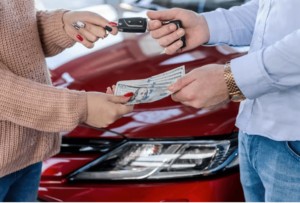Discovering a dent on your car is never a pleasant surprise. Whether it’s a minor ding from a stray shopping cart or a more significant dent from a minor collision, understanding the repair costs is the first step to getting your vehicle back to its pristine condition. If you’re wondering, “how much to repair a dent in car?”, you’re in the right place. This comprehensive guide breaks down the costs associated with car dent repair, the factors that influence pricing, and practical tips to potentially save money without compromising quality.
 Car Dent Repair Cost
Car Dent Repair Cost
The average cost to repair a car dent can fluctuate considerably, generally falling anywhere between $50 and $2,000. This broad range is due to several variables, including the dent’s size and location, the repair technique employed, and whether the damage extends to the paintwork.
To give you a clearer picture, here’s a detailed breakdown of common dent repair types and their typical costs:
| Repair Type | Average Cost | Dent Characteristics |
|---|---|---|
| Paintless Dent Removal (PDR) | $50–$500 | Ideal for small, shallow dents where the paint surface is undamaged, such as door dings or hail dents. |
| Minor Dent Repair with Painting | $200–$750 | Suitable for medium-sized dents that require filling, sanding, and repainting to restore the original finish. |
| Major Dent Repair & Panel Replacement | $800–$3,000+ | For extensive damage from accidents, often necessitating panel replacement, structural repair, and full paint refinishing. |
| Car Door Dent Repair | $75–$600 | Specifically addresses dents on car doors, ranging from minor dings to more significant impacts requiring paintwork. |
| Hail Damage Repair | $150–$2,500+ | Costs vary widely based on the number and size of hail dents across the vehicle, often covered by insurance. |
| Minor Collision Dent Repair | $250–$1,200 | Repairs dents resulting from low-speed accidents, potentially involving bumper or fender damage. |
| Bumper Dent Repair | $350–$2,500 | Bumper repairs can range from simple dent removal to complete replacement, depending on the material and severity of damage. |
| Crease Dent Repair | $250–$1,800 | Repairing sharp, linear dents (creases) demands specialized skills and techniques, impacting the overall cost. |
For dents that are small and haven’t damaged the paint, Paintless Dent Removal (PDR) is often the most economical solution, typically costing between $50 and $500. However, for larger dents, dents in complex areas, or damage that includes scratches or paint loss, traditional repair methods become necessary. These more involved repairs can range from a few hundred to several thousand dollars, particularly if panel replacement and extensive paintwork are required.
Paintless Dent Removal vs. Traditional Car Dent Repair
Choosing between Paintless Dent Removal (PDR) and traditional dent repair methods is a crucial decision that affects not only the repair cost but also the repair time and the integrity of your vehicle’s original paint. Understanding the core differences will empower you to select the best approach for your situation.
PDR and Traditional Repair: A Comparative Overview
| Feature | Paintless Dent Removal (PDR) | Traditional Dent Repair |
|---|---|---|
| Typical Cost Range | $50–$500 | $200–$3,000+ |
| Repair Time | Usually a few hours, often same-day service | Can take 1-5 days, depending on damage complexity |
| Best Suited For | Minor dents, dings, hail damage; intact paint | Larger dents, dents with paint damage, structural issues |
| Environmental Impact | Environmentally friendly; no chemicals or new paint | Less eco-friendly due to materials and paint processes |
| Repair Process | Uses specialized tools to gently massage and reshape metal from behind the panel | Involves sanding down the dent, filling with body filler, priming, and repainting to match the vehicle’s color |
Key Factors Influencing Car Dent Repair Costs
Several elements play a significant role in determining the final cost of your car dent repair. Being aware of these factors will help you understand repair estimates and anticipate potential expenses.
-
Dent Size and Depth: The dimensions of the dent are a primary cost driver. Smaller, shallower dents are inherently less complex to repair, requiring less labor and simpler tools. Conversely, larger, deeper dents demand more extensive work and potentially specialized techniques, increasing the overall cost.
-
Dent Location: Dents situated in easily accessible, flat panels are typically less expensive to repair. However, dents in more complex areas, such as near body lines, curves, or edges, pose a greater challenge. These locations often require more intricate manipulation and may necessitate partial disassembly of vehicle components, leading to higher labor charges.
-
Vehicle Type and Material: The make and model of your car, and especially the material of its body panels, can affect repair costs. Luxury vehicles or cars with aluminum or other specialized body panels often require technicians with specific expertise and tools. Aluminum, for example, is more challenging to work with than steel and may increase labor costs.
-
Paint Condition and Damage: If the dent has compromised the paint layer—resulting in scratches, chips, or cracks—the repair process becomes more involved and costly. Repairs will then include additional steps like sanding, priming, and repainting to seamlessly blend the repaired area with the surrounding paint. Color matching, especially for older or custom paints, can also add to the expense.
-
Repair Method Chosen: As discussed earlier, the choice between PDR and traditional repair significantly impacts cost. PDR is generally less expensive because it avoids the need for painting and materials like body filler and primer. Traditional methods, while necessary for more severe damage, inherently involve more materials and labor, resulting in a higher price tag.
-
Labor Rates: Labor costs are a substantial component of any car repair bill. Body shops and technicians set their hourly rates based on factors like their location, overhead costs, and the expertise of their technicians. Highly skilled technicians specializing in advanced repair techniques may command higher rates. Getting estimates from multiple shops can reveal variations in labor costs within your area.
By considering these factors, car owners can approach dent repair estimates with a more informed perspective and better understand the rationale behind the quoted prices.
Smart Ways to Save Money on Car Dent Repair
Keeping repair costs down is a priority for most car owners. Here are several actionable strategies to help you save money on car dent repair without sacrificing the quality of the work.
-
Obtain Multiple Repair Quotes: Don’t settle for the first estimate you receive. Body shop prices can vary significantly. Getting quotes from at least three different reputable repair shops or dealerships allows you to compare costs and potentially negotiate for a better price.
-
Assess Dent Size and Location for DIY Potential: For very minor, shallow dents in easily accessible areas, consider whether a DIY dent repair kit might be appropriate. These kits are relatively inexpensive and can be effective for small dings. However, proceed with caution; improper DIY attempts can sometimes worsen the damage or harm the paint, leading to more costly professional repairs down the line.
-
Wisely Utilize Car Insurance: Review your car insurance policy to understand your coverage for dent repairs, particularly if the damage is substantial or resulted from an incident like hail or a collision. Weigh the cost of your deductible against the repair cost, and consider the potential impact on your premium if you file a claim. For minor dents, it might be more cost-effective to pay out-of-pocket and avoid a premium increase.
-
Inquire About Warranties: Choose repair shops that offer a warranty on their work. A warranty provides assurance of quality and can save you money in the long run if any issues arise with the repair. It demonstrates the shop’s confidence in their workmanship and commitment to customer satisfaction. Warranties are a sign of a reputable and reliable repair service.
-
Cultivate a Relationship with a Local Body Shop: Building a relationship with a trusted local auto body repair shop can be beneficial. Regular customers may sometimes receive preferential pricing or discounts. Moreover, a reputable shop is more likely to provide honest assessments and high-quality work, helping maintain your car’s value over time.
-
Consider Mobile Dent Repair Services: For Paintless Dent Removal, mobile dent repair services can be a convenient and often cost-effective option. These services come to your location, reducing the overhead costs associated with traditional body shops, which can translate to lower prices for you.
Conclusion: Making Informed Decisions About Car Dent Repair Costs
Understanding the costs associated with car dent repair and the factors that influence them empowers you to navigate the repair process with confidence and make financially sound decisions. By considering the type, size, and location of the dent, exploring different repair methods like PDR and traditional techniques, and actively seeking cost-saving strategies, you can effectively manage dent repairs.
While DIY solutions might be tempting for minor issues, remember that professional expertise often provides the most reliable and long-lasting results, preserving your vehicle’s appearance and value. Armed with the knowledge from this guide, you are better prepared to address car dent repairs economically and efficiently. Don’t hesitate to request professional quotes and thoroughly compare your options before making a decision.
Visit StormWise for Professional Car Dent Repair Services

